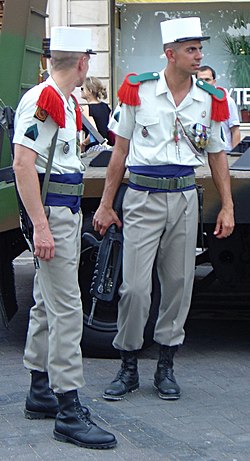Epaulette (pronunciation: /ˈɛpǝlɛt/) is a French word meaning "little shoulder" (from epaule, meaning "shoulder"). Epaulettes are a type of ornamental shoulder piece or decoration used as insignia or rank by the military and other organizations. Colloquially, the word has also come to refer to some types of shoulder strap.

Epaulettes are fastened to the shoulder by a passant, a small strap parallel to the shoulder seam and the button near the collar, or by laces on the underside of the epaulette passing through holes in the shoulder of the coat. The placement of the epaulette, its color and the length and diameter of its bullion fringe are used to signify the wearer's rank. At the join of the fringe and the shoulderpiece is often a metal piece in the form of a crescent. Although originally worn in the field, epaulettes are more common today on dress or ceremonial uniforms. Shoulder straps are also found on civilian clothing that derives from military uniforms such as the trench coat, the safari jacket and other garments.
History of the Epaulette
Originally a French invention, epaulettes were used to indicate rank. The rank of an officer could be determined by whether an epaulette was worn on the left shoulder, the right shoulder or on both. Later a "counter-epaulette" (with no fringe) was worn on the opposite shoulder of those who wore only a single epaulette. Epaulettes were made in silver or gold for officers, and in cloth of various colors for the enlisted men of various arms. By the early eighteenth century, epaulettes became the distinguishing feature of an officer, leading to officers of military units without epaulettes to petition their government for the right to wear epaulettes, to insure that they would be recognized as officers[1]. Certain cavalry specialties wore flexible metal epaulettes referred to as shoulder scales, rarely worn on the field.
In Europe, some light infantry wore cloth counter-epaulettes. "Flying artillery" wore "wings", similar to an epaulette but with only a bit of fringe on the outside, which matched the shoulder seam. Heavy artillery wore small balls representing ammunition on their shoulders.
Today, epaulettes have mostly been replaced by a five-sided flap of cloth called a shoulder strap, which is sewn into the shoulder seam and the end buttoned like an epaulette.
An intermediate form in some services, such as the Russian Army, is the shoulderboard, which neither has a fringe nor extends beyond the shoulder seam.
From the shoulderboard was developed the shoulder mark, a flat cloth tube that is worn over the shoulder strap and carries embroidered or pinned-on rank insignia. The advantages of this are the ability to easily change the insignia as occasions warrant.
United States
Officers of the United States Army at the time of the Civil War wore gold for artillery and silver for infantry. This was in keeping with the practice of the French Army.
Canada
In Canada, epaulette or epaulet is often used (erroneously or colloquially) to describe the shoulder strap of a military or police shirt, jacket or tunic and is used informally as a synonym for slip-on, a flat cloth sleeve (called in the US, a shoulder mark) worn ("slipped on") on the shoulder strap.
After Unification and prior to the issue of the Distinct Environmental Uniform, musicians of the Band Branch wore epaulettes of braided gold cord on the CF uniform.
Epaulettes are still worn on some Army Full Dress, Patrol Dress, and Mess Dress uniforms. Epaulettes in the form of shoulder boards are worn with the officer's white Naval Service Dress.
Germany
German Army uniforms are known for a four cord braided "figure-of-eight" decoration which acts as a shoulder board. This is called a shoulder knot. Although it was once seen on US Army uniforms, it remains only in the mess uniform.
United Kingdom
Before World War I the British Army stopped wearing epaulettes in the field, switching to rank insignia embroidered on the cuffs of the uniform jacket. This was found to make officers a target for snipers, so the insignia was moved to the shoudler straps, where is was less conspicuous.
References
- ^ Wilkinson-Latham, R: "The Royal Navy 1790-1970", page 5. Osprey Publishing, 1977
See also
Epaulettes in the uniform of the Boy Scouts of America